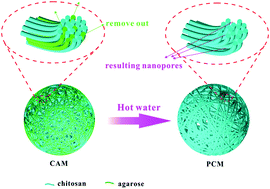The construction of porous chitosan microspheres with high specific surface area by using agarose as the pore-forming agent and further functionalized application in bioseparation†
Abstract
Adsorbents with synchronously high protein adsorption performance and a facile synthetic route are highly desired in protein separation. In this study, a facile yet effective strategy to develop porous chitosan microspheres (PCMs) with high specific surface area (SSA) using agarose as the pore-forming agent is reported. Through heat treatment, the agarose chains in the chitosan/agarose composite microspheres (CAM) were removed, leading to the generation of nanopores/nanochannels and the improvement of SSA. The obtained PCMs showed hierarchical porous structure and a maximum SSA of 246.48 m2 g−1. For the application of PCMs as a protein adsorbent, by modification, the resultant immobilized Cu2+ affinity adsorbent (denoted as Cu2+PCM-15) exhibited a high adsorption capacity (301.88 mg g−1), fast adsorption rate (reaching equilibrium in less than 15 min), and excellent adsorption selectivity for BHb. Together with its environmental-friendliness, and abundant biomass chitosan and agarose, the as-prepared affinity adsorbent with high performance has great application potential in the field of bioseparation.



 Please wait while we load your content...
Please wait while we load your content...